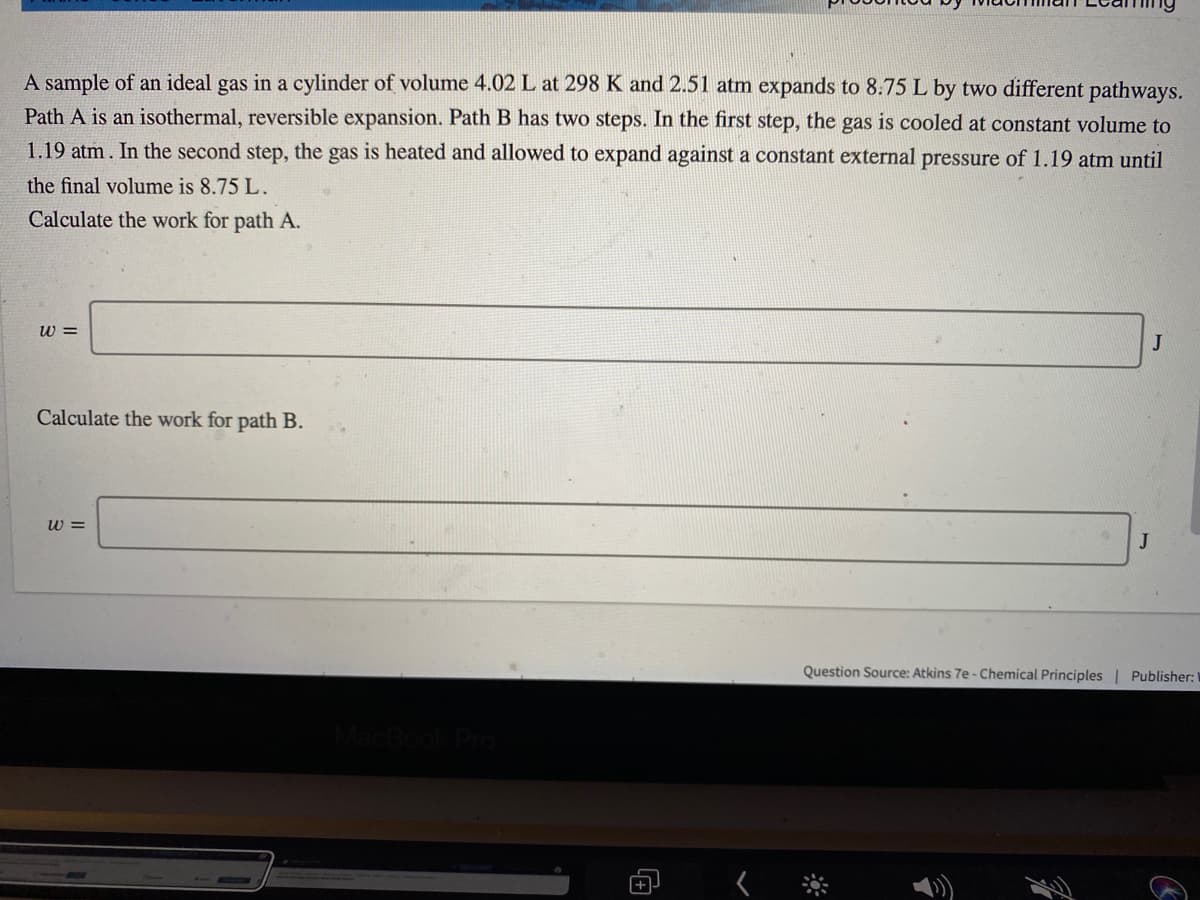A sample of an ideal gas in a cylinder of volume 4.02 L at 298 K and 2.51 atm expands to 8.75 L by two different pathway Path A is an isothermal, reversible expansion. Path B has two steps. In the first step, the gas is cooled at constant volume ta 1.19 atm . In the second step, the gas is heated and allowed to expand against a constant external pressure of 1.19 atm until the final volume is 8.75 L. Calculate the work for path A. w = J Calculate the work for path B.
A sample of an ideal gas in a cylinder of volume 4.02 L at 298 K and 2.51 atm expands to 8.75 L by two different pathway Path A is an isothermal, reversible expansion. Path B has two steps. In the first step, the gas is cooled at constant volume ta 1.19 atm . In the second step, the gas is heated and allowed to expand against a constant external pressure of 1.19 atm until the final volume is 8.75 L. Calculate the work for path A. w = J Calculate the work for path B.
Elements Of Electromagnetics
7th Edition
ISBN:9780190698614
Author:Sadiku, Matthew N. O.
Publisher:Sadiku, Matthew N. O.
ChapterMA: Math Assessment
Section: Chapter Questions
Problem 1.1MA
Related questions
Question

Transcribed Image Text:A sample of an ideal gas in a cylinder of volume 4.02 L at 298 K and 2.51 atm expands to 8.75 L by two different pathways.
Path A is an isothermal, reversible expansion. Path B has two steps. In the first step, the gas is cooled at constant volume to
1.19 atm. In the second step, the gas is heated and allowed to expand against a constant external pressure of 1.19 atm until
the final volume is 8.75 L.
Calculate the work for path A.
w =
J
Calculate the work for path B.
w =
J
Question Source: Atkins 7e - Chemical Principles| Publisher:
Expert Solution
Step 1
Given data:
The initial volume of the ideal gas is
The initial temperature of the ideal gas is
The initial pressure of the ideal gas is
The final volume of the ideal gas is
The final pressure of the ideal gas is
Trending now
This is a popular solution!
Step by step
Solved in 3 steps

Knowledge Booster
Learn more about
Need a deep-dive on the concept behind this application? Look no further. Learn more about this topic, mechanical-engineering and related others by exploring similar questions and additional content below.Recommended textbooks for you

Elements Of Electromagnetics
Mechanical Engineering
ISBN:
9780190698614
Author:
Sadiku, Matthew N. O.
Publisher:
Oxford University Press

Mechanics of Materials (10th Edition)
Mechanical Engineering
ISBN:
9780134319650
Author:
Russell C. Hibbeler
Publisher:
PEARSON

Thermodynamics: An Engineering Approach
Mechanical Engineering
ISBN:
9781259822674
Author:
Yunus A. Cengel Dr., Michael A. Boles
Publisher:
McGraw-Hill Education

Elements Of Electromagnetics
Mechanical Engineering
ISBN:
9780190698614
Author:
Sadiku, Matthew N. O.
Publisher:
Oxford University Press

Mechanics of Materials (10th Edition)
Mechanical Engineering
ISBN:
9780134319650
Author:
Russell C. Hibbeler
Publisher:
PEARSON

Thermodynamics: An Engineering Approach
Mechanical Engineering
ISBN:
9781259822674
Author:
Yunus A. Cengel Dr., Michael A. Boles
Publisher:
McGraw-Hill Education

Control Systems Engineering
Mechanical Engineering
ISBN:
9781118170519
Author:
Norman S. Nise
Publisher:
WILEY

Mechanics of Materials (MindTap Course List)
Mechanical Engineering
ISBN:
9781337093347
Author:
Barry J. Goodno, James M. Gere
Publisher:
Cengage Learning

Engineering Mechanics: Statics
Mechanical Engineering
ISBN:
9781118807330
Author:
James L. Meriam, L. G. Kraige, J. N. Bolton
Publisher:
WILEY